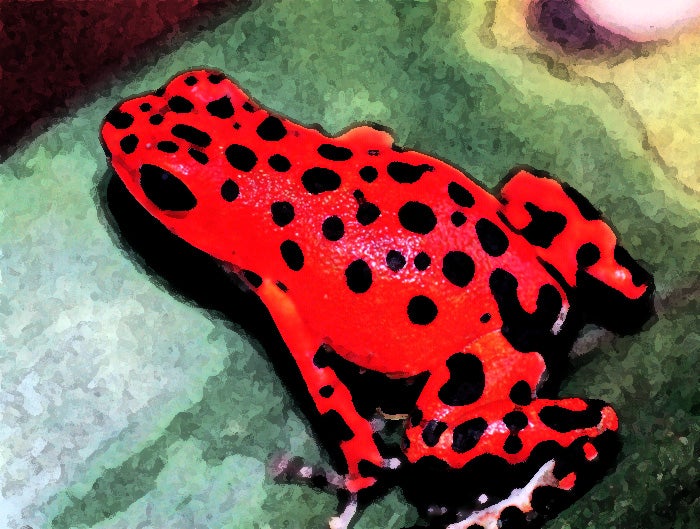So I have decided to Blog about my experiences as a tropical biologist studying Neotropical poison frogs. When I tell people I study the ecology, evolution and behavior of poison frogs, the response I often get is: “How did you get into that field?”. Fair question, but it is a long story. So, this, by way of an introduction, is a brief description of how I got interested in doing research in the Neotropics, and specifically on poison frogs.
My fascination with amphibians and reptiles has always seemed to me to be “innate”, in that it appeared out of nowhere, without much opportunity for observation in the wild (I grew up in New York City). I did not have the opportunity to see many herps in the field until I travelled to Central America when I was eleven years old.
As an eleven year old I had traveled first to Costa Rica with my mother (Elaine Summers), and then later in the same summer to Guatemala with my father (Carol Summers). Those trips may well have influenced me vis-à-vis my fascination with tropical biology in general and tropical herpetofauna in particular. With my mother, we journeyed to a remote house in the jungle in the north, near Puerto Viejo de Sarapiqui, and near the site of the La Selva biological station. I was immediately fascinated by the diverse life forms that were visible as we cruised upriver to the house in a motorized dugout canoe and then walked through the rainforest.
I remember being enthralled as I watched a tarantula hawk paralyzing a tarantula and dragging it to her burrow (tarantula hawk vs. tarantula). This was only the first of many fascinating encounters with wildlife there. We were fortunate to be able to visit the (recently opened) La Selva station and walk the grounds, which was an amazing experience. I specifically recall seeing a tiny, bright red frog with dark blue legs hop out from behind a huge tree buttress – my first encounter with a poison frog (which as the reader may guess was a strawberry poison frog, Oophaga pumilio). I was thrilled to see this gorgeous little living jewel (see photo above for a color variant of this frog from Bastimentos Island in the Bocas del Toro Archipelago in Panama) – little did I know that many years later I would study this very family of frogs for my thesis research, and this very species as a postdoc (Bocas poison frogs – Journal of Heredity: Summers et al. 1997 – see Bocas page for further info).
After this trip, I went on another with an elderly acquaintance of my mother (my mother stayed in San Jose, the capital city) to Tortugero, famous as a breeding site for sea turtles. After an eight-hour journey along a canal in a motorized dugout, we arrived at the field station. Much to my elderly guardian’s dismay, I immediately went out to explore the forest (“Come back or you’ll be dead before dinner!” was her parting shot). In short order, I found a rather large (for an eleven year old) Boa constrictor (it was about six feet long). I grabbed it behind the head (having heard somewhere that this was the thing to do) and brought it back into to station to show my prize to my guardian. Unfortunately, I lost my grip and the snake fell to the floor, then quickly slithered out of sight into a crack in the wall before I could recapture it. Not knowing what to do, I went to find the field station manager. I found him fairly quickly, but before I could explain the situation we were startled by piercing screams coming from my guardian’s room. We raced there, at which point my guardian bolted out of the room, her face ashen, saying that she had been attacked by a giant snake(!) The station manager calmly went into the room and captured the snake, after which I explained what had happened. The station manager was amused, but my guardian was not, and I doubt she every forgave me. That night we went out to see the sea turtles laying their eggs on the beach (see sea turtle laying eggs and sea turtles leaving nest for recent videos of laying and hatching – these events have become large tourist attractions).
After returning from Tortugero, my mother flew home and I flew to Guatemala City to meet my father (Carol Summers), who was traveling in a VW van with his partner at the time. Our travels in Guatemala were amazing, including erupting volcanoes (Mount Fuego erupting), but from a herpetological perspective the highlight was a trip we took to Tikal in the province of Peten. This is an extensive series of Mayan ruins rising from the middle of the jungle (Tikal wildlife). We hiked through the rainforest and overgrown ruins for several days and saw a stunning variety of wildlife, from mysterious trapdoor spiders to noisy and smelly herds of peccaries, and from raucous troops of monkeys to gaudy treefrogs. By the time I returned home, the forests of Central America were firmly fixed in my mind as a paradise of nature, home to an unrivalled menagerie of amphibians and reptiles.
